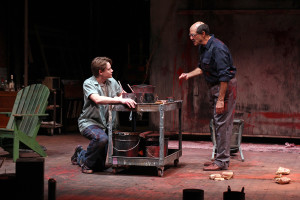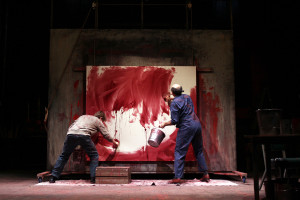The South Coast Repertory Theater’s production of Red, John Logan’s Tony Award winning play about abstract expressionist painter Mark Rothko, which opened in Costa Mesa on January 22, is directed by SCR’s Founding Artistic Director David Emmes and stars Angeleno Mark Harelik as Rothko. Harelik, a tall, slender man with a full head of hair, shaved the top half of his head and adopted a slightly stooped stance for the part. Based on his extensive research, the composed actor also affected a dogmatic, bullying persona.

Paul David Story and Mark Harelik in John Logan’s Red at South Coast Repertory. Photo by Debora Robinson-SCR
As the play begins in 1958, Rothko sits in his dreary downtown Manhattan studio, wearing paint-spattered clothing, staring at the audience, presumably contemplating his newest red painting. When his assistant, Ken (Paul David Story), enters, Harelik proclaims in a booming voice, “What do you see? Wait. Stand closer. You’ve got to get close. Let it pulsate. Let it work on you…There. Let it spread out, Let it wrap its arms around you …” This opening scene is so visceral that it seems as though the actor is channeling the artist. Harelik was still in acting mode during our phone interview. Provoked by the simplest questions, he launched into meandering, heartfelt responses: “Rothko gravitated to Nietzsche. His The Birth of Tragedy explains that we are comprised of two forces, the Dionysian, or the explosive, and the Apollonian or the rational, which keeps us from killing each other. And both are distilled in Rothko’s art.”

Paul David Story and Mark Harelik in John Logan’s Red at South Coast Repertory. Photo by Debora Robinson-SCR
Asked to comment on his portrayal of Rothko, he said: “The play is mentally gripping from moment to moment. You can’t disengage for even a second.” He added, “Playing Rothko has given me a deeper understanding of the meaning of his paintings. He divided the art world into high and low art. Low art contains that which is on the surface. But high art puts you in a state of suspended awe. Rothko’s works bypass your brain and speak to your soul, like music does.”
“Playing this part has changed me,” Harelik reflected. “Experiencing Rothko’s relationship with his art has deepened my own understanding of what it is to create. Some people have said that this play has revived their understanding of Rothko, and they want to spend more time with his art, to let his paintings work on them. Art, whether it is theater or painting, demands that viewers take the time to go beneath the surface.”
Harelik has spent many hours at L.A’s Museum of Contemporary Art, perusing the Rothko’s paintings. “I have spent an almost uncomfortable amount of time in the Rothko room,” he said. “I have watched people come and go, and saw many spend only 30 seconds with each painting. But Rothko’s pieces are wounded when someone walks into the room and then walks out.”


